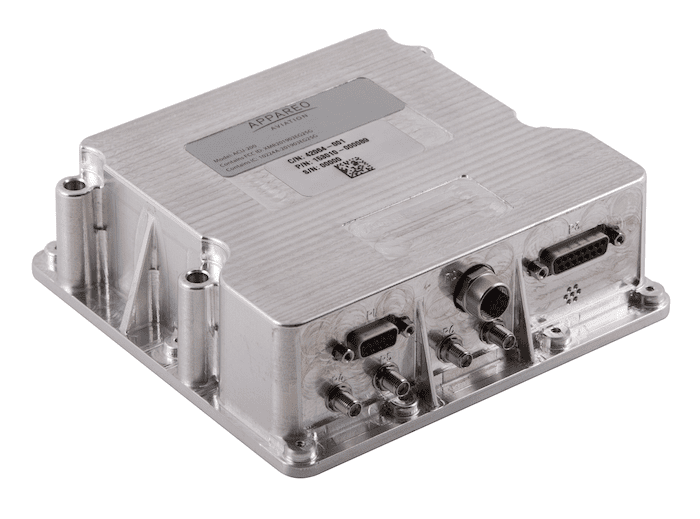 Appareo’s new Conexus technology brings new data acquisition capabilities to the lighter end of the business and general aviation industry. Photo: Appareo
Appareo’s new Conexus technology brings new data acquisition capabilities to the lighter end of the business and general aviation industry. Photo: AppareoA new set of data acquisition, flight data monitoring recording
technology developed by Appareo is designed to bring some of the post-flight data
transmission and analytics capabilities that airlines have been adopting in
recent years to smaller general aviation aircraft.
The North Dakota avionics manufacturer unveiled a lineup of
new computing hardware and software updates over the last month designed to
make access and analysis of flight data easier among business and general
aviation fleet operators. Appareo’s most recent release include their June 3
unveiling of Conexus, a new set of aircraft communications units (ACUs)
designed to act as data acquisition systems for flight data monitoring.
Through Ethernet, ARINC 429 or RS-422, Conexus can acquire
data while in-flight so that it can be retrieved and analyzed post-flight.
“The Conexus ACU-200 has an embedded cellular modem that is
connected to an antenna. That antenna can either be mounted to the ACU-200
itself or to the fuselage, depending on the aircraft. The product is
telematically enabled solely to provide offload of data from the ACU-200 after
the aircraft has landed, it’s not intended to operate the cellular function in
flight,” Appareo CEO David Batcheller told Avionics.
Each ACU-200 consists of dual-core ARM cortex A9 processors,
an LTE cellular radio that relies on 3G/2G as a fallback and a short-range 433
MHz radio. Since the technology provides access to the data after a flight is
complete and features embedded cellular connectivity – there is no additional
investment in any type of satcom or air to ground connectivity required to
enable it.
Another capability featured on Conexus is its ability to
transfer information without the removal of an SD card from a flight data
recorder. Appareo has also demonstrated its ability to be integrated into the
cockpit voice and image recorder technology that the company also has also
developed for light jets.
Prior to unveiling the Conexus ACU-200, on Apr. 29, Appareo
announced a new addition to its line of flight
data recording modules, the Recoverable Data Module, model 300 (RDM-300).
 Appareo’s new flight data recording module is about the size of a pen. Photo: Appareo
Appareo’s new flight data recording module is about the size of a pen. Photo: AppareoBatcheller describes RDM-300 as being adaptable to any type
of aircraft, although the company is targeting the general aviation segment
with the RDM-300, which is designed to automatically accommodate an aircraft’s
bus speed and adjust its configuration to desired data recording preferences.
“The RDM-300 is typically installed by aircraft
manufacturers on either type certificate or supplemental type certificates obtained
in the factory. The product connects to data sources from avionics, or other
sources such data output from a FADEC and stores that data to memory,
overwriting old data in a FIFO fashion. The product can also be installed by
operators looking to improve the recoverability of data from incidents or
accidents, finding an installation location in their aircraft where the unit
can be stored and reasonably wired into data output from avionics,” Batcheller
said.
Smaller general aviation aircraft are not required by civil aviation regulatory agencies in the U.S. or internationally to feature the type of flight data recorders mandated on larger commercial airliners. The National Transportation Safety Board, within its 2019-2020 “Most Wanted List,” included a recommendation for the FAA to start requiring flight data monitoring on smaller U.S.-registered aircraft in an effort to improve safety.
In March, the FAA published a response to the recommendation
noting that it is not considering proposal of such regulations.
“The FAA is not considering rulemaking at this time for
these recommendations. The FAA will examine possible ways of polling operators
through our aviation safety inspectors to identify voluntary flight data
monitoring (FDM) system equipage rates,” the agency said.
RDM-300 is capable of recording more than 500 flight parameters per second within its solid-state memory and weighs less than two pounds. Airframe manufacturers can also configure the module to collect cockpit voice recorder or image data as well.
On the software side of flight data monitoring, Appareo also introduced a major architectural upgrade to EnVision, the web-based application it provides to operators for access to past and current flight data and generation of detailed trend monitoring reports. In a May 18 press release, the company describes how the EnVision system previously only accepted flight data captured by the Apparel Vision 1000 cockpit recorder.
Under the update, the application can now accept flight data
from other devices provided by other companies. The technology analyzes data
uploaded to Appareo servers for analysis after being transferred from an
aircraft to a local computer using an SD card. That transmission can happen
instantaneously or it can be scheduled for a different time of day, based on
the user’s preferences.
“The scheduling feature was developed for our customers who
have operations in remote locations with limited internet bandwidth,”
Batcheller said. “They appreciate the ability to schedule their data file
transmission to take place during periods of low network activity.”